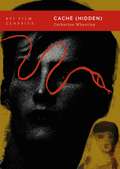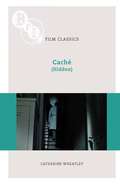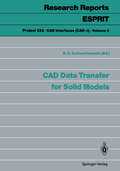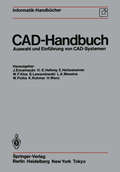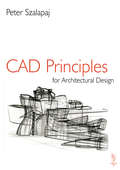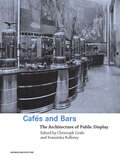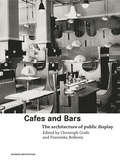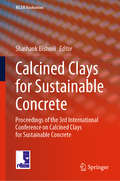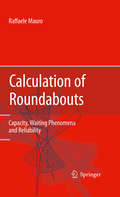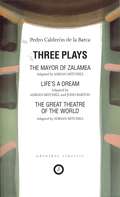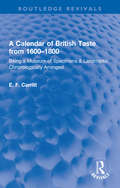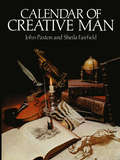- Table View
- List View
Caché (BFI Film Classics)
by Catherine WheatleyEver since its world premiere at the Cannes film festival in May 2005, audiences have been talking about Michael Haneke's Caché. The film's enigmatic and multi-layered narrative leaves its viewers with many more questions than answers. The plot revolves around the mystery of who is sending a series of sinister videos and drawings to Georges Laurent (Daniel Auteuil), the presenter of a literary talkshow. As Georges becomes increasingly secretive, much to the distress of his wife Anne (Juliette Binoche), a culprit fails to surface. And even at the film's end, audiences are left struggling to make sense of what has gone before.This hasn't stopped people trying. In an in-depth and illuminating account, Wheatley examines the key themes at the heart of the 'meaning' of Caché: the film as thriller; post-colonial bourgeois guilt; political accountability and lastly, reality, the media and its audiences, tracing these strands through the film by means of close readings of individual scenes and moments. Inspired by the director's claim that we might understand the film as a set of Russian dolls, each of which is complete in itself but together forms a whole in which layers of unseen depth are concealed, Wheatley avoids a single, unifying approach to understanding Caché. Instead, her detailed analysis of the film's shifting perspectives opens up the multiplicity of meanings that Caché contains, in order to understand its secrets.This edition includes a new foreword in which the author reflects upon Caché in the context of Haneke's subsequent work, and considers the film's contemporary resonances in an era of omnipresent surveillance technology and doctored 'fake news' videos.
Caché (BFI Film Classics)
by Catherine WheatleyEver since its world premiere at the Cannes film festival in May 2005, audiences have been talking about Michael Haneke's Caché. The film's enigmatic and multi-layered narrative leaves its viewers with many more questions than answers. The plot revolves around the mystery of who is sending a series of sinister videos and drawings to Georges Laurent (Daniel Auteuil), the presenter of a literary talkshow. As Georges becomes increasingly secretive, much to the distress of his wife Anne (Juliette Binoche), a culprit fails to surface. And even at the film's end, audiences are left struggling to make sense of what has gone before.This hasn't stopped people trying. In an in-depth and illuminating account, Wheatley examines the key themes at the heart of the 'meaning' of Caché: the film as thriller; post-colonial bourgeois guilt; political accountability and lastly, reality, the media and its audiences, tracing these strands through the film by means of close readings of individual scenes and moments. Inspired by the director's claim that we might understand the film as a set of Russian dolls, each of which is complete in itself but together forms a whole in which layers of unseen depth are concealed, Wheatley avoids a single, unifying approach to understanding Caché. Instead, her detailed analysis of the film's shifting perspectives opens up the multiplicity of meanings that Caché contains, in order to understand its secrets.This edition includes a new foreword in which the author reflects upon Caché in the context of Haneke's subsequent work, and considers the film's contemporary resonances in an era of omnipresent surveillance technology and doctored 'fake news' videos.
Cache (BFI Film Classics)
by Catherine WheatleyEver since its world premiere at the Cannes film festival in May 2005, audiences have been talking about Michael Haneke's Caché. The film's enigmatic and multi-layered narrative leaves its viewers with many more questions than answers. The plot revolves around the mystery of who is sending a series of sinister videos and drawings to Georges Laurent (Daniel Auteuil), the presenter of a literary talkshow. As Georges becomes increasingly secretive, much to the distress of his wife Anne (Juliette Binoche), a culprit fails to surface. And even at the film's end, audiences are left struggling to make sense of what has gone before.This hasn't stopped people trying. As Catherine Wheatley examines, a wealth of critical writing surrounds Caché, with various explanations having been offered as to what the film is 'really' about. In an in-depth and illuminating account, Wheatley examines the key themes at the heart of the 'meaning' of Caché: the film as thriller; post-colonial bourgeois guilt; political accountability and lastly, reality, the media and its audiences, tracing these strands through the film by means of close readings of individual scenes and moments. Inspired by the director's claim that we might understand the film as a set of Russian dolls, each of which is complete in itself but together forms a whole in which layers of unseen depth are concealed, Wheatley avoids a single, unifying approach to understanding Caché. Instead, her detailed analysis of the film's shifting perspectives opens up the multiplicity of meanings that Caché contains, in order to understand its secrets. ?Ever since its world premiere at the Cannes film festival in May 2005, audiences have been talking about Michael Haneke's Caché. The film's enigmatic and multi-layered narrative leaves its viewers with many more questions than answers.
CAD and Rapid Prototyping for Product Design (Portfolio Skills)
by Douglas BrydenComputer-aided design (CAD) and rapid prototyping (RP) are now a fundamental part of the professional practice of product design and are therefore essential skills for product design undergraduate students. This book provides students with all the tools needed to get to grips with the range of both CAD software and RP processes used in the industry. Presented in a visually engaging format, this book is packed with case study examples from contemporary product designers, as well as screen shots, CAD models and images of rapid prototypes highlighting the design process. This book shows how CAD and RP software is used in product design and explains, in clear language, the similarities and differences between the different software packages and processes.
CAD Based Programming for Sensory Robots: Proceedings of the NATO Advanced Research Workshop on CAD Based Programming for Sensory Robots held in Il Ciocco, Italy, July 4-6, 1988 (NATO ASI Subseries F: #50)
by Bahram RavaniThis book contains 26 papers presented at the NATO Advanced Research Workshop on "CAD Based Programming for Sensory Robots," held in IL CIOCCa, Italy, July 4-6, 1988. CAD based robot programming is considered to be the process where CAD (Computer Based) models are used to develop robot programs. If the program is generated, at least partially, by a programmer interacting, for example, with a computer graph i c d sp i 1 ay of the robot and its workce 11 env ironment, the process is referred to as graphical off-line programming. On the other hand, if the robot program is generated automatically, for example, by a computer, then the process is referred to as automatic robot programmi ng. The key element here is the use of CAD models both for interact i ve and automat i c generat i on of robot programs. CAD based programmi ng, therefore, bri ngs together computer based model i ng and robot programmi ng and as such cuts across several discipl ines including geometric model ing, robot programming, kinematic and dynamic modeling, artificial intelligence, sensory monitoring and so-on.
CAD Data Transfer for Solid Models (Research Reports Esprit #3)
by E. G. SchlechtendahlPrincipal authors: U. Kroszynski, B. Palstr9Sm 1.1 The evolution of concepts and specifications for CAD data exchange The CAD/CAM community has witnessed, during the last decade, the appearance of several specifications as well as proposals for standards which either attempt to cover wider areas or to be more reliable and stable than the others. With the rapid evolution of both hardware and software, the capabilities offered by CAD systems and CAD based application systems are far more advanced than they were only ten years ago, even when they are now based on micro-computers or personal comput ers. The situation with standards, however, is not and cannot be so. In order to be reliable and accepted by a wide community of both vendors and users, a standard has to be sta ble. This implies a life span of at least a decade. This also implies that the standard has to be general and flexible enough to accommodate present as well as expected future developments. 1.1.1 IGES The initial development of concepts for CAD data exchange is strongly influenced by the US Integrated Computer Aided Manufacturing (ICAM) programme, that dealt with the development of methods for data exchange. In September 1979, a subgroup was estab lished with participation of the National Bureau of Standards, the General Electric Com pany, and the Boeing Company. The result of this effort was the Initial Graphics Exchange Specification (IGES) that was published as a NBS report [61] in 1980.
CAD-Datenaustausch und -Datenverwaltung: Schnittstellen in Architektur, Bauwesen und Maschinenbau (Beiträge zur Graphischen Datenverarbeitung)
by Helmut R. WeberDie in diesem Band zusammengestellten Beiträge einer Seminarreihe am Zentrum für Graphische Datenverarbeitung behandeln Schnittstellenproblematiken aus einem aktuellen Bereich der CAD-Anwendungen. Zunehmende Komplexität der angebotenen Systeme, ein größerer Verbreitungsgrad und das Bedürfnis verschiedenartiger Partner, ihre Daten und Arbeiten auszutauschen, erzeugen vielfältige Probleme. Die Auswahl der Beiträge zeigt, daß Benutzer, Hersteller, Anwender oder Vermittler je nach Betrachtungswinkel ganz unterschiedliche Schwerpunkte sehen. Alle Schnittstellenprobleme werden gleichermaßen als relevant und wichtig eingestuft, aber bei den Strategien zu ihrer Lösung werden große Unterschiede deutlich. So wurden auch bisherige Normungsaktivitäten wie STEPS, IGES, SET, VDAFS, PDDI, ESP, PDES als nicht ausreichend oder verfrüht betrachtet. Die fachliche Verteilung der Beiträge zeigt den Stand der Nutzung von CAD in Maschinenbau, Bauwesen und Architektur: Während im Maschinenbau die Einführung und Nutzung von CAD fast zum alltäglichen Geschäft geworden ist, stehen Bauwesen und Architektur noch an der Einführungsschwelle. Die Probleme dort sind besonders groß, da die marktgängigen Systeme aus dem Maschinenbaubereich kommen und den fachspezifischen Anforderungen nicht genügen. Dies führt zum Entwurf eigener Systeme, zum Teil mit ganz unterschiedlichen Voraussetzungen, Methodiken, Datenstrukturen und Benutzeroberflächen.
CAD for Fashion Design and Merchandising: - with STUDIO
by Stacy Stewart SmithIt takes more than raw talent and passion to make it in today's global apparel and accessories markets-excellent computer-aided design skills are a prerequisite. CAD for Fashion Design and Merchandising allows students to immediately begin creating digital fashion presentations using Adobe Illustrator® and Photoshop®. This book takes an integrated approach, allowing students to master the three-dimensional benefits of combining the two software programs. Colorful illustrations accompany easy, step-by-step tutorials that are geared toward students at the beginner and intermediate levels. Because the book uses fashion photography rather than hand-drawn illustrations as a basis for demonstrating the proportion of fashion croquis, instructors will be able to evaluate students' mastery of digital illustration regardless of their hand-drawing skills, and students will benefit from a seamless transition from creative thought to digital rendering.
CAD Fundamentals for Architecture (Portfolio Skills)
by Elys JohnComputer-aided design (CAD) is the dominant design and drawing tool used in architecture, and all students need to acquire basic skills in using it. This book explains the key CAD skills required to create plans, 3D models and perspectives. Detailed text and hundreds of screengrabs and visuals are used to demonstrate the various techniques and processes. 2D skills are shown using AutoCAD, SketchUp and Vectorworks, while 3D modelling and presentation techniques also include 3ds Max, Maya, Form·Z and Photoshop. The reader will learn how to simplify the software interface and tools in order to focus on the most common and useful tasks. This is an invaluable guide for all students of architecture.
CAD-Handbuch: Auswahl und Einführung von CAD-Systemen (Informatik-Handbücher)
by J. Encarnacao H. E. Hellwig E. Hettesheimer W. F. Klos S. Lewandowski L. A. Messina W. Poths K. Rohmer H. WenzCAD Principles for Architectural Design
by Peter SzalapajCAD Principles for Architectural Design is aimed at design students and practitioners interested in understanding how CAD is used in architectural practice. This book makes connections between the basic operations that are common to most CAD systems, and their use in practice on actual architectural design projects. The ways in which CAD is integrated into the design processes of several leading edge practices is illustrated. Arising from these case studies is the emergence of a contemporary phenomenon of integrated CAD, in which all aspects of design schemes are brought together within computational frameworks that support the analysis of design proposals.Szalapaj's view of CAD is one in which computers constitute a medium in which designers can express design ideas, rather than viewing computers as problem solving machines. For creative designers to successfully exploit CAD technology, CAD systems should reflect designers' intuitions as described by designers themselves
CAD Principles for Architectural Design
by Peter SzalapajCAD Principles for Architectural Design is aimed at design students and practitioners interested in understanding how CAD is used in architectural practice. This book makes connections between the basic operations that are common to most CAD systems, and their use in practice on actual architectural design projects. The ways in which CAD is integrated into the design processes of several leading edge practices is illustrated. Arising from these case studies is the emergence of a contemporary phenomenon of integrated CAD, in which all aspects of design schemes are brought together within computational frameworks that support the analysis of design proposals.Szalapaj's view of CAD is one in which computers constitute a medium in which designers can express design ideas, rather than viewing computers as problem solving machines. For creative designers to successfully exploit CAD technology, CAD systems should reflect designers' intuitions as described by designers themselves
Cafes and Bars: The Architecture of Public Display (Interior Architecture)
by Christoph Grafe Franziska BollereyThe design of bars and cafes has played an important role in the development of architecture in the twentieth century. This influence has been felt particularly strongly over the past thirty years, in a time when these social spaces have contributed significantly to the rediscovery and reinvention of cities across Europe and North America. This volume presents and examines this significant urban architectural production, and discusses it against a background of the design of cafes and bars across the nineteenth and twentieth centuries. Major themes and developments are discussed and illustrated with case studies, from the functionalist pre-World War Two architects in Central Europe representing modern society through the design of public spaces, right up to the design of sophisticated bars and cafes as part of the recent urban renaissance of Barcelona and Paris in 1980s and London in the '90s.
Cafes and Bars: The Architecture of Public Display (Interior Architecture)
by Christoph Grafe Franziska BollereyThe design of bars and cafes has played an important role in the development of architecture in the twentieth century. This influence has been felt particularly strongly over the past thirty years, in a time when these social spaces have contributed significantly to the rediscovery and reinvention of cities across Europe and North America. This volume presents and examines this significant urban architectural production, and discusses it against a background of the design of cafes and bars across the nineteenth and twentieth centuries. Major themes and developments are discussed and illustrated with case studies, from the functionalist pre-World War Two architects in Central Europe representing modern society through the design of public spaces, right up to the design of sophisticated bars and cafes as part of the recent urban renaissance of Barcelona and Paris in 1980s and London in the '90s.
Cage-based Performance Capture (Studies in Computational Intelligence #509)
by Yann SavoyeNowadays, highly-detailed animations of live-actor performances are increasingly easier to acquire and 3D Video has reached considerable attentions in visual media production. In this book, we address the problem of extracting or acquiring and then reusing non-rigid parametrization for video-based animations. At first sight, a crucial challenge is to reproduce plausible boneless deformations while preserving global and local captured properties of dynamic surfaces with a limited number of controllable, flexible and reusable parameters. To solve this challenge, we directly rely on a skin-detached dimension reduction thanks to the well-known cage-based paradigm. First, we achieve Scalable Inverse Cage-based Modeling by transposing the inverse kinematics paradigm on surfaces. Thus, we introduce a cage inversion process with user-specified screen-space constraints. Secondly, we convert non-rigid animated surfaces into a sequence of optimal cage parameters via Cage-based Animation Conversion. Building upon this reskinning procedure, we also develop a well-formed Animation Cartoonization algorithm for multi-view data in term of cage-based surface exaggeration and video-based appearance stylization. Thirdly, motivated by the relaxation of prior knowledge on the data, we propose a promising unsupervised approach to perform Iterative Cage-based Geometric Registration. This novel registration scheme deals with reconstructed target point clouds obtained from multi-view video recording, in conjunction with a static and wrinkled template mesh. Above all, we demonstrate the strength of cage-based subspaces in order to reparametrize highly non-rigid dynamic surfaces, without the need of secondary deformations. To the best of our knowledge this book opens the field of Cage-based Performance Capture.
Cahiers du Cinema: Interviews with Film Directors, 1953-1970
by James R RussoCahiers du Cinema: Interviews with Film Directors, 19531970 brings together eighteen directorsOtto Preminger, Roberto Rossellini, John Ford, Howard Hawks, Max Ophuls, Nicholas Ray, Orson Welles, Fritz Lang, Alain Resnais, Jean-Luc Godard, Francois Truffaut, Michelangelo Antonioni, Carl-Theodor Dreyer, Federico Fellini, Robert Bresson, Joseph L. Mankiewicz, Jean Renoir, and Eric Rohmer -- who are among the leading auteurs in the history of the cinema. The interviews were all commissioned for the legendary movie journal Cahiers du Cinema (the oldest such French-language magazine in continuous publication), the first critical enterprise to treat films, particularly Hollywood films, as a serious art form. Co-founded in 1951 by Andre Bazin, Jacques Doniol-Valcroze, and Joseph-Marie Lo Duca, Cahiers was edited, after 1957, by Rohmer himself, including among its writers (and interviewers) Jacques Rivette, Godard, Claude Chabrol, and Truffaut -- all of whom went on to become highly influential filmmakers. Conducted in Cahiers famously in-depth, critical and engaged style, the interviews in this volume catch each director at a crucial juncture in his development as an artist, and stand as a historical record of the dominance of the Euro-American tradition in cinematic art. This is the first such collection of its kind in English, edited with a contextualizing introduction, critical biographies, career filmographies, and a comprehensive index by the American scholar James R. Russo.
Calcined Clays for Sustainable Concrete: Proceedings of the 3rd International Conference on Calcined Clays for Sustainable Concrete (RILEM Bookseries #25)
by Shashank BishnoiThis volume comprises the proceedings of the Third International Conference on Calcined Clays for Sustainable Concrete held in New Delhi, India in October 2019. The papers cover topics related to geology of clay, hydration and performance of blended systems with calcined clays, alkali activated binders, and economic and environmental impacts of the use of calcined clays in cement-based materials. The book presents research on influence of processing on reactivity of calcined clays, influence of clay mineralogy on reactivity, geology of clay deposits, and the environmental impact of use of calcined clays in cement and concrete and field applications of calcined clay in concrete. Apart from giving an overview of the progress of research during the last two years, this work also covers the state-of-the art on the practical aspects of production and use of calcined clays in construction. The contents of this volume will prove useful to researchers and graduate students working in the areas of cement chemistry, cement production, and concrete design.
Calculation of Roundabouts: Capacity, Waiting Phenomena and Reliability
by Raffaele MauroRoundabouts have become one of the most significant traffic control measures because they are generally statistically safer and more efficient than traditional at grade intersections. This book is dedicated to the evaluation of the operating conditions of roundabouts. In five parts, it thoroughly illustrates the calculation of the capacity, including reliability, and waiting phenomena parameters, such as the times spent in the system and queue lengths. Fully worked examples are included throughout the chapters, with detailed explanations.
Calculus for Computer Graphics
by John VinceStudents studying different branches of computer graphics have to be familiar with geometry, matrices, vectors, rotation transforms, quaternions, curves and surfaces and as computer graphics software becomes increasingly sophisticated, calculus is also being used to resolve its associated problems. In this 2nd edition, the author extends the scope of the original book to include applications of calculus in the areas of arc-length parameterisation of curves, geometric continuity, tangent and normal vectors, and curvature. The author draws upon his experience in teaching mathematics to undergraduates to make calculus appear no more challenging than any other branch of mathematics. He introduces the subject by examining how functions depend upon their independent variables, and then derives the appropriate mathematical underpinning and definitions. This gives rise to a function’s derivative and its antiderivative, or integral. Using the idea of limits, the reader is introduced to derivatives and integrals of many common functions. Other chapters address higher-order derivatives, partial derivatives, Jacobians, vector-based functions, single, double and triple integrals, with numerous worked examples, and over a hundred and seventy colour illustrations. This book complements the author’s other books on mathematics for computer graphics, and assumes that the reader is familiar with everyday algebra, trigonometry, vectors and determinants. After studying this book, the reader should understand calculus and its application within the world of computer graphics, games and animation.
Calculus for Computer Graphics
by John VinceStudents studying computer animation and computer games have to be familiar with geometry, matrices, vectors, rotation transforms, quaternions, curves and surfaces, and as computer graphics software becomes increasingly sophisticated, calculus is also being used to resolve its associated problems.The author draws upon his experience in teaching mathematics to undergraduates to make calculus appear no more challenging than any other branch of mathematics. He introduces the subject by examining how functions depend upon their independent variables, and then derives the appropriate mathematical underpinning and definitions. This gives rise to a function’s derivative and its antiderivative, or integral. Using the idea of limits, the reader is introduced to derivatives and integrals of many common functions. Other chapters address higher-order derivatives, partial derivatives, Jacobians, vector-based functions, single, double and triple integrals, with numerous worked examples, and over a hundred illustrations. Calculus for Computer Graphics complements the author’s other books on mathematics for computer graphics, and assumes that the reader is familiar with everyday algebra, trigonometry, vectors and determinants. After studying this book, the reader should understand calculus and its application within the world of computer games and animation.
Calculus for Computer Graphics
by John VinceStudents studying different branches of computer graphics need to be familiar with geometry, matrices, vectors, rotation transforms, quaternions, curves and surfaces. And as computer graphics software becomes increasingly sophisticated, calculus is also being used to resolve its associated problems.In this 3rd edition, the author extends the scope of the original book to include vector differential operators and differential equations and draws upon his experience in teaching mathematics to undergraduates to make calculus appear no more challenging than any other branch of mathematics. He introduces the subject by examining how functions depend upon their independent variables, and then derives the appropriate mathematical underpinning and definitions. This gives rise to a function’s derivative and its antiderivative, or integral. Using the idea of limits, the reader is introduced to derivatives and integrals of many common functions. Other chapters address higher-order derivatives, partial derivatives, Jacobians, vector-based functions, single, double and triple integrals, with numerous worked examples and almost two hundred colour illustrations. This book complements the author’s other books on mathematics for computer graphics and assumes that the reader is familiar with everyday algebra, trigonometry, vectors and determinants. After studying this book, the reader should understand calculus and its application within the world of computer graphics, games and animation.
Calderon: Three Plays (Oberon Classics)
by John Barton Pedro Calderon de la Barca Adrian MitchellIncludes the plays: The Mayor of Zalamea, Life's a Dream, The Great Theatre of the WorldIn The Mayor of Zalamea, commissioned by the Royal National Theatre, peasants’ honour clashes with military discipline. Life’s a Dream is Calderón’s most famous philosophical play. The Great Theatre of the World is an allegorical work that would originally have been performed in the street to the accompaniment of music and dancing.
A Calendar of British Taste from 1600–1800: Being a Museum of Specimens & Landmarks Chronologically Arranged (Routledge Revivals)
by E. F. CarrittFirst published in 1948, A Calendar of British Taste from 1600–1800 gives a picture of British taste in art, nature and manners during the centuries 1600 to 1800. The book is an anthology from novels, poetry, letters, essays, advertisements and diaries of the period. It is arranged chronologically and covers a wide range of topics including architecture, gardens, manners, music, nature, painting, poetry, sculpture, and the stage. Key authors drawn upon include Pepys, Dryden, Pope, Horace Walpole, Dr. Johnson, Fanny Burney, Cowper, and Wordsworth. Through an extensive and panoramic view, the book traces the development and changes in taste over time. A Calendar of British Taste from 1600–1800 is ideal for anyone with an interest in the cultural and social history of Britain.
A Calendar of British Taste from 1600–1800: Being a Museum of Specimens & Landmarks Chronologically Arranged (Routledge Revivals)
by E. F. CarrittFirst published in 1948, A Calendar of British Taste from 1600–1800 gives a picture of British taste in art, nature and manners during the centuries 1600 to 1800. The book is an anthology from novels, poetry, letters, essays, advertisements and diaries of the period. It is arranged chronologically and covers a wide range of topics including architecture, gardens, manners, music, nature, painting, poetry, sculpture, and the stage. Key authors drawn upon include Pepys, Dryden, Pope, Horace Walpole, Dr. Johnson, Fanny Burney, Cowper, and Wordsworth. Through an extensive and panoramic view, the book traces the development and changes in taste over time. A Calendar of British Taste from 1600–1800 is ideal for anyone with an interest in the cultural and social history of Britain.
